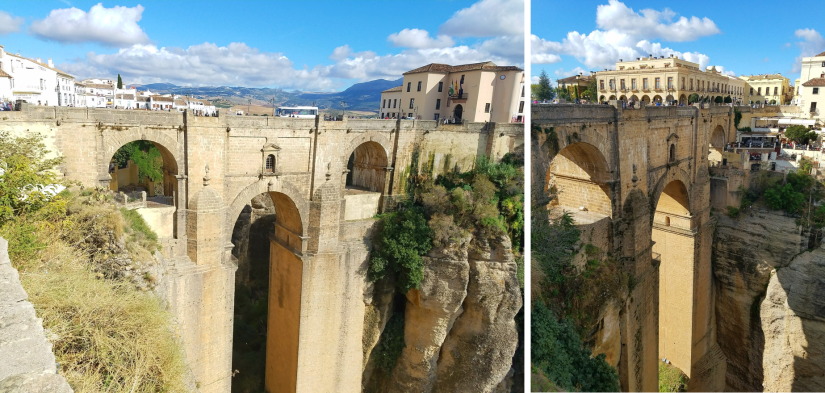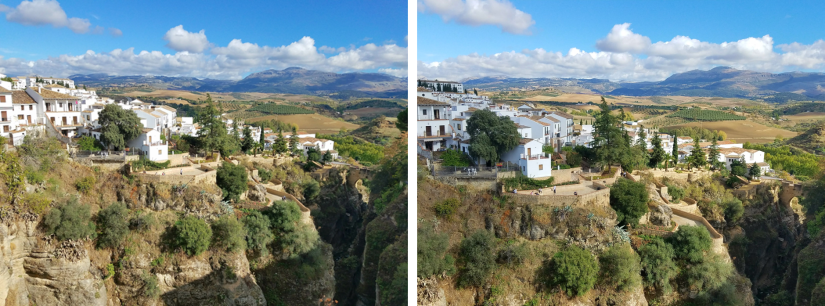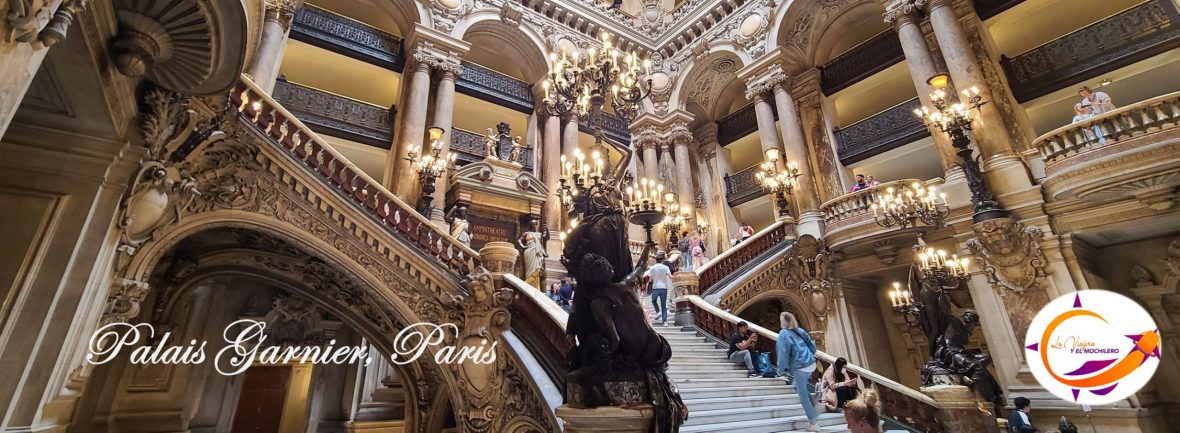We first became familiar with Ronda on account of some very impressive photos of the “Puerte Nuevo sobre el Tajo” (New Bridge) we found surfing the internet.  Each picture viewed fueled our desires to someday visit it. Ronda is part of the “Málaga” province, a very small city which made getting to it by bus or train (from “Astigi / Écija”) virtually impossible.
Each picture viewed fueled our desires to someday visit it. Ronda is part of the “Málaga” province, a very small city which made getting to it by bus or train (from “Astigi / Écija”) virtually impossible.
Our new friends from “Écija”, Rafa, Elena and the infant Alejandro, made our trip to Ronda a reality. Our drive began mid-morning arriving at Ronda early in the afternoon.
The transition from to the city to the historic area began at the “Alameda del Tajo” (a tree grove) with an impressive view of the valley below and a mountain range in the distance. Much like many other cities in Andalusia and Spain, Ronda was founded on a mountain top.
Much like many other cities in Andalusia and Spain, Ronda was founded on a mountain top.
 We strolled by the “Plaza de Toros” and continued towards the New Bridge. Our expectations were completely satisfied upon contemplating this marvel, which although having a short span is an immense structure over the gorge of the “Guadalevin” River. A spectacle worth viewing from all angles.
We strolled by the “Plaza de Toros” and continued towards the New Bridge. Our expectations were completely satisfied upon contemplating this marvel, which although having a short span is an immense structure over the gorge of the “Guadalevin” River. A spectacle worth viewing from all angles.
From the bridge we could view the hanging gardens of “Cuenca” (“Jardines de Cuenca”) and once over the bridge we could view its beauty from the “Mirador de Aldehuela” and the “Balcón del Coño”.
and once over the bridge we could view its beauty from the “Mirador de Aldehuela” and the “Balcón del Coño”.
We stopped in front of the “Lara” Museum  at the old palace of the Counts of “la Conquista de las Islas Batanes” to enjoy a very good local wine and snacks. Let us not forget a traditional platter of the region, “Guiso de rabo de toro” (Bull’s tail stew).
at the old palace of the Counts of “la Conquista de las Islas Batanes” to enjoy a very good local wine and snacks. Let us not forget a traditional platter of the region, “Guiso de rabo de toro” (Bull’s tail stew).
On this side of the bridge we gained access to the “Old Quarters” of the old and historic city. It was here that we found many palaces such as the Palaces of “Mondragón”, “Duquesa de Parcent”, “Marques de Salvatierra”, “del Rey Moro” and “San Juan Bosco”, among others. We were pleasantly surprised to find the “Colegiata de Santa María la Mayor” available for viewing. When planning our trip we had been advised that it would be closed for restoration works. A few steps beyond that, the Bandit’s Museum (“Museo del Bandido”).
When planning our trip we had been advised that it would be closed for restoration works. A few steps beyond that, the Bandit’s Museum (“Museo del Bandido”).
View more photos at the following link: Ronda
Our trip to Ronda would not be complete without the walk down the hill to the city walls and the “Puerta de Almocabar” (ancient gateway to the city) to then climb back to vist the “Minar de San Sebastián”, “la Puerta de los Esparteros” and even “las Murallas del Carmen”. We also viewed the Holy Ghost Church (“Iglesia del Espíritu Santo”).
to then climb back to vist the “Minar de San Sebastián”, “la Puerta de los Esparteros” and even “las Murallas del Carmen”. We also viewed the Holy Ghost Church (“Iglesia del Espíritu Santo”).
We parted from Ronda in the evening but not without stopping anew to enjoy this marvelous city.
On our way back to “Écija”, our hosts decide to make a detour to provide more surprises. We dropped into the city of “Osuna”, neighboring “Écija” and arrived at the “Insigne Iglesia Colegial” or “la Colegiata de Osuna”, home to a Museum of Religious artworks. From this vantagepoint we got a spectacular view of the city totally lit.
home to a Museum of Religious artworks. From this vantagepoint we got a spectacular view of the city totally lit.
The route back to the “Palacio de los Granados” experienced another detour, this time to the highest part of the city where we enjoyed another wonderful view of the city of “Écija” illuminated.
Gratefully we said our good-byes to Rafa, Elena and Alejandro for being our accomplices and making our dream of visiting Ronda come true.

